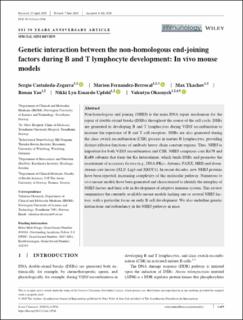| dc.contributor.author | Castaneda Zegarra, Sergio Miguel | |
| dc.contributor.author | Fernandez Berrocal, Marion Silvana | |
| dc.contributor.author | Tkachev, Max | |
| dc.contributor.author | Yao, Rouan | |
| dc.contributor.author | Esnardo Upfold, Nikki Lyn | |
| dc.contributor.author | Oksenych, Valentyn | |
| dc.date.accessioned | 2021-01-12T09:44:12Z | |
| dc.date.available | 2021-01-12T09:44:12Z | |
| dc.date.created | 2020-07-17T08:53:30Z | |
| dc.date.issued | 2020 | |
| dc.identifier.citation | Scandinavian Journal of Immunology. 2020, 92:e12936 (4), 1-9. | en_US |
| dc.identifier.issn | 0300-9475 | |
| dc.identifier.uri | https://hdl.handle.net/11250/2722494 | |
| dc.description.abstract | Non-homologous end joining (NHEJ) is the main DNA repair mechanism for the repair of double-strand breaks (DSBs) throughout the course of the cell cycle. DSBs are generated in developing B and T lymphocytes during V(D)J recombination to increase the repertoire of B and T cell receptors. DSBs are also generated during the class switch recombination (CSR) process in mature B lymphocytes, providing distinct effector functions of antibody heavy chain constant regions. Thus, NHEJ is important for both V(D)J recombination and CSR. NHEJ comprises core Ku70 and Ku80 subunits that form the Ku heterodimer, which binds DSBs and promotes the recruitment of accessory factors (e.g., DNA-PKcs, Artemis, PAXX, MRI) and downstream core factors (XLF, Lig4 and XRCC4). In recent decades, new NHEJ proteins have been reported, increasing complexity of this molecular pathway. Numerous in vivo mouse models have been generated and characterized to identify the interplay of NHEJ factors and their role in development of adaptive immune system. This review summarizes the currently available mouse models lacking one or several NHEJ factors, with a particular focus on early B cell development. We also underline genetic interactions and redundancy in the NHEJ pathway in mice. | en_US |
| dc.language.iso | eng | en_US |
| dc.publisher | Wiley Online Library | en_US |
| dc.rights | Navngivelse 4.0 Internasjonal | * |
| dc.rights.uri | http://creativecommons.org/licenses/by/4.0/deed.no | * |
| dc.title | Genetic interaction between the non‐homologous end joining factors during B and T lymphocyte development: in vivo mouse models | en_US |
| dc.type | Peer reviewed | en_US |
| dc.type | Journal article | en_US |
| dc.description.version | publishedVersion | en_US |
| dc.source.pagenumber | 1-9 | en_US |
| dc.source.volume | 92:e12936 | en_US |
| dc.source.journal | Scandinavian Journal of Immunology | en_US |
| dc.source.issue | 4 | en_US |
| dc.identifier.doi | 10.1111/sji.12936 | |
| dc.identifier.cristin | 1819659 | |
| dc.description.localcode | This is an open access article under the terms of the Creative Commons Attribution License, which permits use, distribution and reproduction in any medium, provided the original work is properly cited. © 2020 The Authors. Scandinavian Journal of Immunology published by John Wiley & Sons Ltd on behalf of The Scandinavian Foundation for Immunology | en_US |
| cristin.ispublished | true | |
| cristin.fulltext | original | |
| cristin.qualitycode | 1 | |

